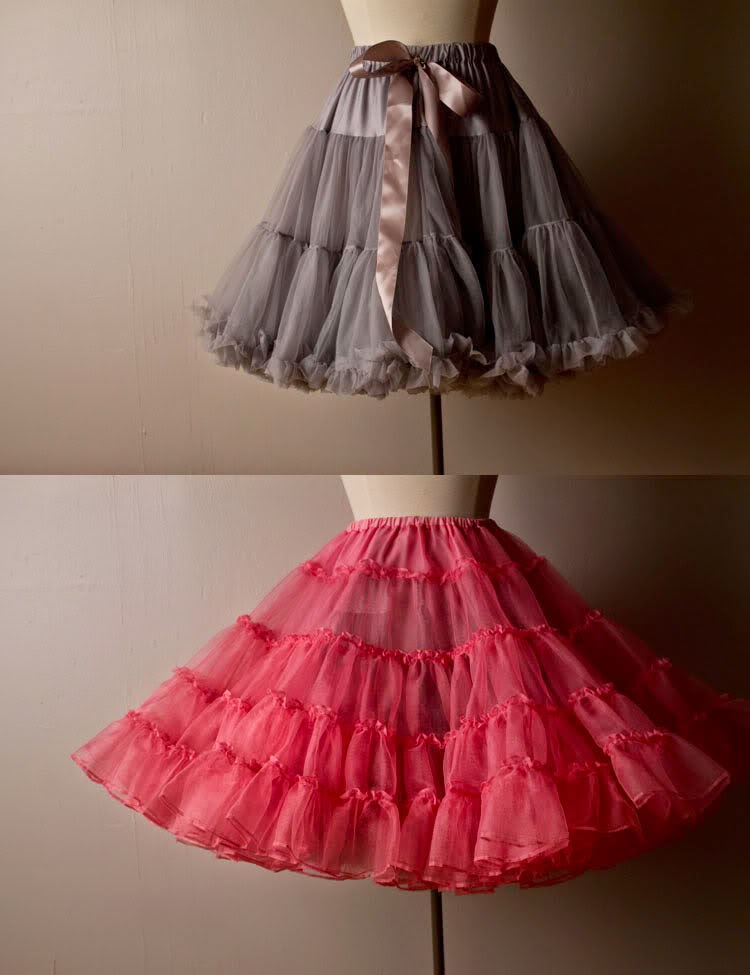Petticoat
A petticoat or underskirt is an article of clothing for women; specifically an undergarment to be worn under a skirt or a dress. The petticoat is a separate garment hanging from the waist (unlike the chemise).
 |
| 1960s |
In historical contexts (sixteenth to mid-nineteenth centuries), petticoat refers to any separate skirt worn with a gown, bedgown, bodice or jacket; these petticoats are not, strictly speaking, underwear as they were made to be seen. In both historical and modern contexts, petticoat refers to skirt-like undergarments worn for warmth or to give the skirt or dress the desired fashionable shape. In this context a petticoat may be called a waist slip or underskirt (UK) or half slip (US), with petticoat restricted to extremely full garments. Petticoat can also refer to a full-length slip in the UK,although this usage is somewhat old-fashioned.
Petticoat is the standard name in English for any underskirt worn as part of non-Western clothing, most significantly, the lehenga with the sari.
The practice of wearing petticoats as undergarments was well established by 1585. Petticoats were worn throughout history by women who wanted to have the currently fashionable shape created by their clothing. The petticoat(s), if sufficiently full or stiff, would hold the overskirt out in a pleasingly domed shape and give the impression of a smaller waist than the wearer actually had. It would also complement the desired large bust.
Elaborately decorated petticoats were worn under open-fronted gowns and looped overskirts from the mid-sixteenth century. Eighteenth century petticoats of wool or silk were often quilted for additional warmth and were worn with matching short gowns or jackets, which could be fashioned like a man's jacket with military details and trimmings. These ankle-length petticoats remained a rural fashion, especially in the UK, into the nineteenth century and are a part of Welsh national dress.
Modern petticoats
For the first two decades of the twentieth century, multiple petticoats fell out of fashion; narrow, sometimes tight, skirts became more common. Then, in the late 1920s, chiffon dresses with several sheer petticoats became fashionable. With the Great Depression in the 1930s, narrow skirts returned and petticoats again were unpopular until the end of the decade when revived for some evening, prom, and wedding gowns. World War II, with its rationing and general shortage of materials, brought an end to petticoats.
Petticoats were revived by Christian Dior in his full-skirted "New Look" of 1947 and tiered, ruffled, stiffened petticoats remained extremely popular during the 1950s, especially with teenage girls. Most of the petticoats were netlike crinoline, sometimes made of horsehair. Increasingly, nylon chiffon, taffeta, and organdy were used in petticoats. Many department stores carried an extensive variety of styles and colors of petticoats until the early 1960s. They were also available through the famous Sears and J.C. Penney catalogues. Typically, at least three single petticoats were worn, until manufacturers began making double and triple layer petticoats. A narrow slip was usually worn under the petticoats, especially the crinoline type, because they tended to be "scratchy".
Edith Head designed a number of gowns and dresses, supported by multiple layers of petticoats, for actresses such as Grace Kelly and Doris Day, who appeared in Alfred Hitchcock films in the 1950s.Dinah Shore frequently wore dresses with petticoats on her NBC television shows[citation needed] Actress Connie Stevens, who appeared in television series and movies, said she wore petticoats as long as possible because she had wide hips. Other entertainers who often wore petticoats were Brenda Lee, Connie Francis, and Patti Page.
Petticoats today
Lately the full, tiered petticoat has made a small comeback in the alternative subcultures, especially the gothic and Lolita subculture. They have also been popular with some cross-dressers. Various petticoats have also been used in films and musicals dealing with the 1950s, such as Grease, West Side Story, Peggy Sue Got Married, and Back to the Future, as well as occasional vintage rock music festivals, especially in Germany Although the traditional purpose for the petticoat is no longer in fashion, the general design has stayed the same with minor alterations including ripping and/or the usage of bright or generally non-traditional colors to fit in with modern fashion.
Petticoats are also making a comeback due to recent trends towards lavish weddings and grandiose bridal attire. Petticoats are commonly worn under bridal gowns with full skirts as a means of maintaining the gown's intended silhouette.
Also, people who dress in period costumes have begun wearing petticoats for a more authentic look. A number of websites offer a great variety of petticoats for sale, while other websites show historic and modern photographs of petticoats, often worn by models.
The everyday use of petticoats in the 1950s and early 1960s appears to have passed.




EmoticonEmoticon